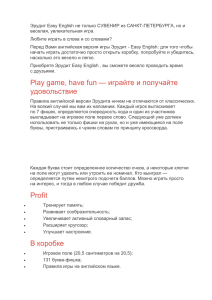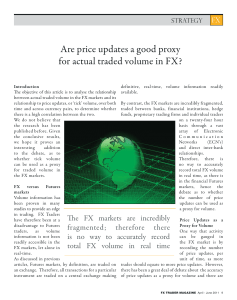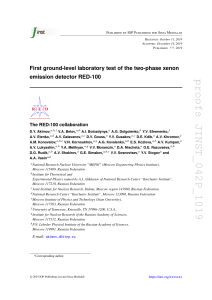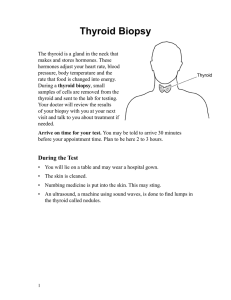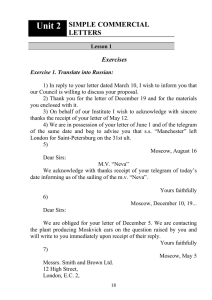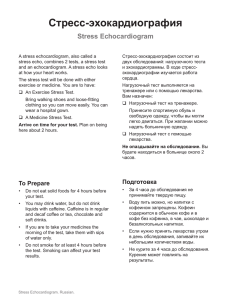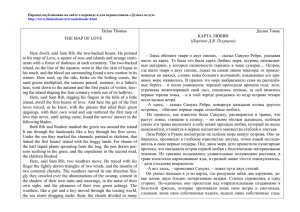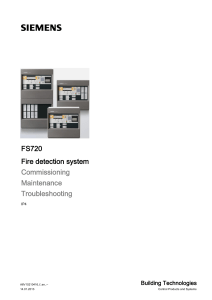Корреляционные методики измерениия сверхкоротких
реклама
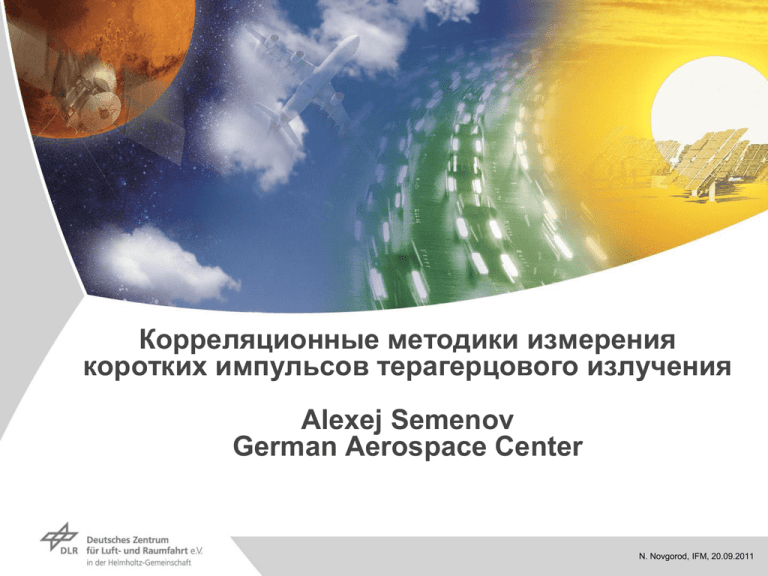
Корреляционные методики измерения коротких импульсов терагерцового излучения Alexej Semenov German Aerospace Center N. Novgorod, IFM, 20.09.2011 Outline Коррелляция и автокорреляция Нелинейность и интерференция в автокорреляционных измерениях электромагнитных полей - электрическое поле - интенсивность - Crosstalk Получение коротких терагерцовых импульсов Результаты измерений Folie 2 Fluorescent Correlation Spectroscopy Magde, D., Elson, E., and Webb, W.W. (1972) Phys. Rev. Lett. 29, 705 Fluorescent Correlation Spectroscopy Autocorrelation function Wz Wx,y G( ) I (t ) T (t ) I (t ) 2 1 1 1 N 1 8 D 1 4 D 2 2 w w x , y z N – average number of the molecules in the focal volume D – diffusion coefficient Fluorescent Correlation Spectroscopy Diffusion coefficient Different light - time correlation of photons Thermal sources, gas discharge (natural light) - bunched photons (Bose statistics, strong fluctuation) Lasers (coherent light) - random photons (Poisson distribution, low fluctuation) Single photon sources (fluorescence, quantum dot) - anti-bunched photons Folie 6 Time correlation of photons Correlation function with a single photon detector Tkoh is the measure for the degree of coherence in thermal light sources C. Zinoni et al., APL 2007 Folie 7 Time correlation of photons Hanbury-Brown/Twiss-Experiment Finite response time and/or dead time of a single photon detector brought up the HBT method Folie 8 Outline Коррелляция и автокорреляция Нелинейность и интерференция в автокорреляционных измерениях электромагнитных полей - электрическое поле - интенсивность - Crosstalk Получение коротких терагерцовых импульсов Результаты измерений Folie 9 Femtosecond pulse lasers How to measure the pulse duration? Autocorrelator Interferometric autocorrelation SHD – second harmonic generator (non-linear optical crystal) D – any slow detector Folie 10 Interferometric autocorrelation Interferometric autocorrelation Two ultra-short pulses (a) and (b) with their respective interferometric autocorrelation (c) and (d). Because of the phase present in pulse (b) due to an instantaneous frequency sweep (chirp), the fringes of the autocorrelation trace (d) wash out in the wings. Note the ratio 8:1 (peak to the wings), characteristic of interferometric autocorrelation traces. Folie 11 Fast optical detectors How to measure the response time of the detector? Use the nonlinearity V(P) of the detector response and do not forget to eliminate interference Interferometer P V L – femtosecond pulse laser P – polarizer V – slow voltmeter D –detector under study A. Semenov et al., JLTP 1996 Folie 12 Intensity autocorrelation YBCO superconducting detector and Ti-Sapphire laser Interferometer 1.3 1.25 Correlation signal (r.u.) P R1fl R2fl GAUSS 7 ps V 1.2 1.15 1.1 1.05 1 0.95 0.9 -30 -20 -10 0 10 20 30 Delay (ps) P. Probst et al., PRB <2012> Folie 13 Intensity autocorrelation Intensity autocorrelation V(I) a I 2 V(t) a ( E1(t) E2 (t) )2 2 2 Two ultra-short pulses (a) and (b) with their respective intensity autocorrelation (c) and (d). Because the intensity autocorrelation ignores the temporal phase of pulse (b) that is due to the instantaneous frequency sweep (chirp), both pulses yield the same intensity autocorrelation. Here, identical Gaussian temporal profiles have been used, resulting in an intensity autocorrelation width twice as long as the original intensities. Note that an intensity autocorrelation has a background that is ideally half as big as the actual signal. The zero in this figure has been shifted to omit this background Folie 14 Fast optical detectors How to measure the linear response time? Use the mutual current drain of two identical detectors L. Shi et al., APL 1992 Crosstalk correlation Folie 15 Crosstalk correlation I0 = const Crosstalk correlation I2 I1 R2 (t) R1 (t+ ) R( t ) (I( t ) IC ) I( t )n InC (1 P( t )) R1, 2 ( t ) R0 R( t, I) I1R1 I2R 2 V ( t ) I1 I2 i0 Folie 16 Outline Коррелляция и автокорреляция Нелинейность и интерференция в автокорреляционных измерениях электромагнитных полей - электрическое поле - интенсивность - Crosstalk Получение коротких терагерцовых импульсов Результаты измерений Folie 17 THz Synchrotron Radiation Synchrotron radiation Signal appearance Bending magnet J. Feikes et al., PR ST AB 2011 Folie 19 Synchrotron radiation Typical values e 25 ps t e 0.035 fs Folie 20 Coherent synchrotron radiation c v bunch length (x) 10 ps re(x) orbit acceptance portion 25 ps Coherence condition x < l Folie 21 Coherent THz Radiation from a Synchrotron reference orbit: L = 240 m longitudinal bunch length intensity vs. number of electrons hn normal user optics sz > 5 mm t > 35 ps sz > l L = vc bunch, p hn 7·10-3 low alpha optics sz 1 mm momentum compaction factor: p/p = L/L fs2 t < 7 ps sz l 10-4 10 ps Single electron 1 ps window THz -pulse Synchrotron MLS data sheet Folie 23 Outline Коррелляция и автокорреляция Нелинейность и интерференция в автокорреляционных измерениях электромагнитных полей - электрическое поле - интенсивность - Crosstalk Получение коротких терагерцовых импульсов Результаты измерений Folie 24 Problems Radiation pulses in the range 0.1 – 1 THz Pulse duration 10 – 20 ps Available detectors Slow – semiconductor bolometers (linear) Fast – superconducting electron bolometers (linear) Fast – superlattice detector (non-linear) Beam size a few millimeters & detector size a few micrometers Folie 25 Antennensimulation Au-Antenne (100nm) auf Saphir S11=-18 dB bei f = 0,95 THz Antennen + Filter Layout Gesamtstruktur Antennen + Filter S-Parameter im THz-Bereich • S11 = S22 = -43 dB bei 0,95 THz • S21 = S12 = -32 dB sowie S31 = S32 = -24 dB bei 0,95 THz Signal wird gut in Antenne eingekoppelt und nur wenig reflektiert Martin-Puplett Interferometer Input 1 Input 2 Output Folie 30 Typical autocorrelation signal Combination from crosstalk correlation and field correlation Normalized Autocorrelation signal Beam parameter: 629 MeV, 480 kV, 7.05 kHz, 100mA beam current Streak camera: FWHM) = 26ps Normalize to [0, 1] of B GaussAmpFit von C 1.0 0.5 0.0 -60 -50 -40 -30 -20 -10 0 10 20 30 40 50 60 Time (ps) Detector signals seem to overlap over the whole scan length Negative autocorrelation signal Neither the peak at 0 nor the whole response corresponds with the streak camera measurements Period of about 20 ps Peak at zero shorter than the other peaks Field detector Dielectric mirror Metallic mirror THz response (mV) 10 5 I0 = const 0 -5 0.0 0.2 0.4 0.6 0.8 1.0 I2 I1 R2 Time (ns) (t) R1 (t+ ) Folie 32 Field autocorrelation Two ultra-short pulses (a) and (b) with their respective field autocorrelation (c) and (d). Note that the autocorrelations are symmetric and peak at zero delay. Note also that unlike pulse (a), pulse (b) exhibits an instantaneous frequency sweep, called chirp, and therefore contains more bandwidth than pulse (a). Therefore, the field autocorrelation (d) is shorter than (c), because the spectrum is the Fourier transform of the field autocorrelation (Wiener-Khinchin theorem). Folie 33 Autocorrelation with superlattice detector S. Winnerl et al., APL 1998 Combination from field and intensity correlation Folie 34 Thank you Folie 35
